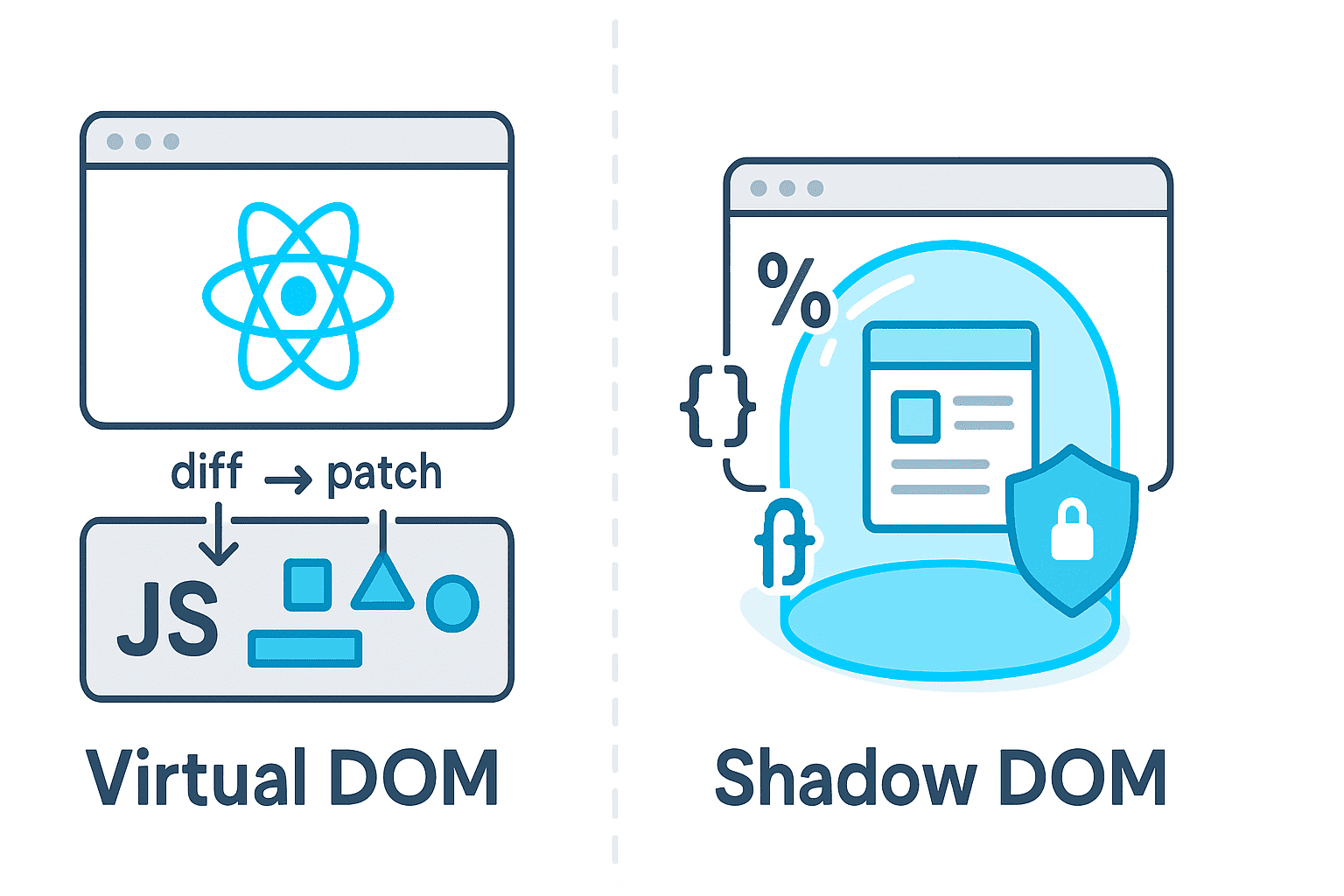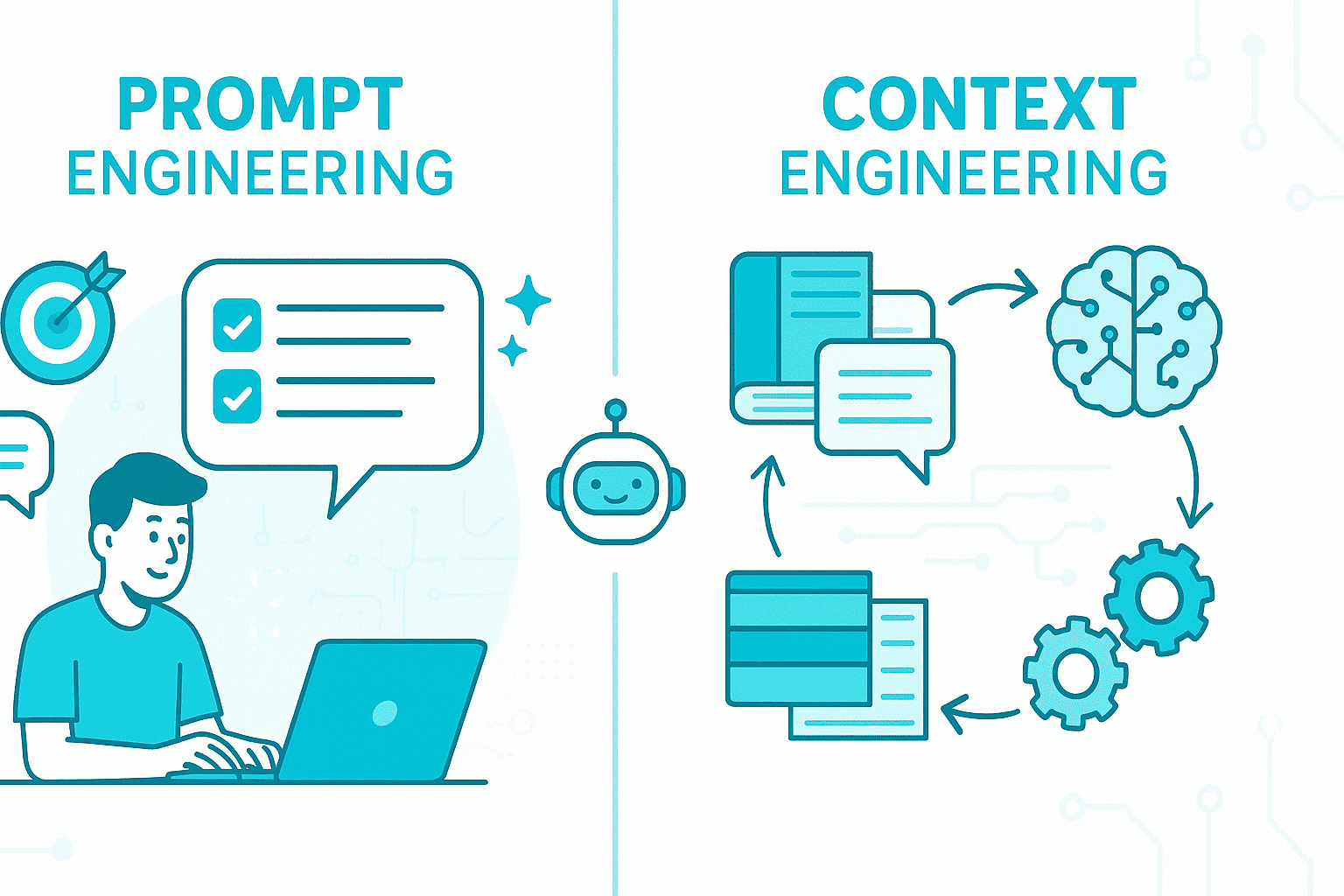If you're a React developer, you're likely intimately familiar with the Virtual DOM - that clever abstraction that makes React so performant. But there's another DOM concept that deserves your attention: the Shadow DOM. Despite the similar naming, these are completely different technologies solving entirely different problems. The Shadow DOM is a powerful browser feature that enables true isolation and encapsulation for UI components, and understanding it can level up your web development skills beyond framework-specific knowledge.
While the Virtual DOM helps React efficiently update the UI, the Shadow DOM is a browser-native feature that creates isolated DOM trees with their own scope for HTML and CSS. Think of it as a protective bubble around your component - a mini sandbox where your styles and structure can't be contaminated by the outside world, and vice versa. This distinction is crucial for building truly reusable, framework-agnostic components.
What is Shadow DOM? A Browser-Native Feature Explained
The Shadow DOM is a web standard that allows you to attach a hidden, isolated DOM tree to an element in your regular DOM. This isn't a React feature, Vue feature, or any framework-specific concept - it's built directly into modern browsers as part of the Web Components specification.
When you create a Shadow DOM, you're essentially creating a boundary that separates a chunk of the DOM from the rest of your document. This boundary provides two critical benefits: style encapsulation and DOM encapsulation. Your Shadow DOM has its own scope, completely isolated from the parent document.
Here's a simple example of creating a Shadow DOM:
// Create a custom element
class MyComponent extends HTMLElement {
constructor() {
super();
// Attach a shadow root to the element
const shadow = this.attachShadow({ mode: "open" });
// Add content to the shadow DOM
shadow.innerHTML = `
<style>
p {
color: blue;
font-weight: bold;
}
</style>
<p>This text is styled within the Shadow DOM</p>
`;
}
}
// Register the custom element
customElements.define("my-component", MyComponent);
In this example, the <p> tag inside the Shadow DOM will be blue and bold, regardless of any global CSS rules in your document. Even if you have a rule like p { color: red; } in your main stylesheet, it won't affect this paragraph.
Shadow DOM vs Virtual DOM: Different Problems, Different Solutions
This is where many developers get confused. The names sound similar, but the Shadow DOM and Virtual DOM are fundamentally different technologies designed to solve different challenges.
Virtual DOM: Efficient UI Updates
The Virtual DOM is a React concept (also used by other frameworks like Vue). It's a lightweight JavaScript representation of the actual DOM that React maintains in memory. When your component state changes, React:
- Creates a new Virtual DOM tree
- Compares it with the previous version (diffing)
- Calculates the minimal set of changes needed
- Updates only those specific parts of the real DOM
The Virtual DOM exists to make UI updates faster and more efficient. It's a performance optimization technique that reduces expensive DOM manipulation operations.
Shadow DOM: Isolation and Encapsulation
The Shadow DOM, on the other hand, is all about isolation and encapsulation. It creates a boundary around your component so that:
- CSS styles are scoped: Styles defined inside the Shadow DOM don't leak out, and external styles don't leak in
- DOM structure is hidden: The internal DOM structure is encapsulated and hidden from the parent document
- JavaScript selectors are scoped:
document.querySelector()won't find elements inside a Shadow DOM
Here's a comparison table:
| Feature | Virtual DOM | Shadow DOM |
|---|---|---|
| Type | JavaScript abstraction | Browser API |
| Purpose | Efficient UI updates | Isolation & encapsulation |
| Created by | Framework (React, Vue) | Browser (Web Standard) |
| Main benefit | Performance | Style and DOM scoping |
| Use case | Dynamic UI rendering | Reusable components |
The Power of CSS Isolation in Shadow DOM
One of the most compelling features of the Shadow DOM is CSS isolation. This solves a problem that has plagued web developers for years: CSS conflicts and specificity wars.
How CSS Isolation Works
When you define styles inside a Shadow DOM, they are completely scoped to that shadow tree. This means:
<!-- Your main document -->
<style>
p {
color: red;
font-size: 16px;
}
</style>
<p>This paragraph is red</p>
<custom-widget></custom-widget>
// Inside your custom element
class CustomWidget extends HTMLElement {
constructor() {
super();
const shadow = this.attachShadow({ mode: "open" });
shadow.innerHTML = `
<style>
p {
color: green;
font-size: 24px;
text-decoration: underline;
}
</style>
<p>This paragraph is green and unaffected by external styles</p>
`;
}
}
customElements.define("custom-widget", CustomWidget);
In this example:
- The first
<p>tag will be red with 16px font - The
<p>tag inside the Shadow DOM will be green with 24px font and underlined - Neither affects the other
This is incredibly powerful for component libraries and design systems. You can guarantee that your component will look exactly the same regardless of what CSS exists on the page where it's used.
Real-World Benefits of Style Encapsulation
The CSS isolation provided by Shadow DOM solves several practical problems:
- No naming conflicts: You don't need complex naming conventions like BEM or CSS Modules
- Predictable styling: Your component styles won't be overridden by user stylesheets
- Simplified maintenance: You can style components without worrying about global CSS impact
- True reusability: Components can be dropped into any project without style pollution
[IMAGE: Diagram showing Shadow DOM boundary preventing CSS from crossing in either direction]
Shadow DOM in the Wild: Real Browser Examples
You've actually been using Shadow DOM for years without realizing it. Browsers use Shadow DOM internally to implement complex UI controls with their own internal structure.
Native Elements Using Shadow DOM
Open your browser's DevTools and inspect a <video> element. You'll notice it has controls - play button, progress bar, volume slider - but you don't see those elements in your HTML. They're hidden inside a Shadow DOM.
Common elements that use Shadow DOM internally:
<video>- media controls<audio>- media controls<input type="range">- slider track and thumb<input type="date">- calendar picker<input type="file">- file selection button<textarea>- scrollbars and text rendering
To see the Shadow DOM in Chrome DevTools:
- Open DevTools (F12)
- Go to Settings (gear icon)
- Under Elements, check "Show user agent shadow DOM"
- Inspect a
<video>or<input type="range">element
This reveals the hidden complexity that browsers encapsulate using Shadow DOM. It's the same technology you can use for your own components.
Building Components with Shadow DOM and Web Components
The Shadow DOM really shines when combined with Web Components to create truly reusable, framework-agnostic UI elements.
Creating a Practical Web Component
Let's build a custom tooltip component using Shadow DOM:
class CustomTooltip extends HTMLElement {
constructor() {
super();
// Create shadow root
const shadow = this.attachShadow({ mode: "open" });
// Create tooltip structure
const wrapper = document.createElement("div");
wrapper.setAttribute("class", "tooltip-wrapper");
const icon = document.createElement("span");
icon.setAttribute("class", "icon");
icon.textContent = "?";
const tooltipContent = document.createElement("div");
tooltipContent.setAttribute("class", "tooltip-content");
tooltipContent.textContent = this.getAttribute("text") || "Tooltip text";
// Add styles (completely isolated)
const style = document.createElement("style");
style.textContent = `
.tooltip-wrapper {
position: relative;
display: inline-block;
}
.icon {
display: inline-block;
width: 20px;
height: 20px;
border-radius: 50%;
background: #007bff;
color: white;
text-align: center;
cursor: help;
font-size: 14px;
line-height: 20px;
}
.tooltip-content {
visibility: hidden;
position: absolute;
bottom: 125%;
left: 50%;
transform: translateX(-50%);
background-color: #333;
color: white;
padding: 8px 12px;
border-radius: 4px;
white-space: nowrap;
font-size: 14px;
z-index: 1000;
opacity: 0;
transition: opacity 0.3s;
}
.tooltip-wrapper:hover .tooltip-content {
visibility: visible;
opacity: 1;
}
`;
// Attach everything to shadow DOM
shadow.appendChild(style);
wrapper.appendChild(icon);
wrapper.appendChild(tooltipContent);
shadow.appendChild(wrapper);
}
}
// Register the component
customElements.define("custom-tooltip", CustomTooltip);
Now you can use this component anywhere in your HTML:
<p>
Hover for more info
<custom-tooltip text="This is helpful information!"></custom-tooltip>
</p>
The beauty here is that:
- The tooltip styles won't conflict with any page styles
- The component works in any framework (React, Vue, Angular) or vanilla JavaScript
- The internal DOM structure is encapsulated and protected
- You can reuse this across multiple projects without modification
When to Use Shadow DOM vs Framework Solutions
Understanding when to use Shadow DOM versus framework-specific solutions is important for making architectural decisions.
Use Shadow DOM When
- Building framework-agnostic components: You need components that work everywhere
- Creating component libraries: You're shipping components to be used in unknown environments
- Style isolation is critical: You absolutely need CSS encapsulation
- Long-term maintenance: You want components that survive framework changes
- Third-party widgets: You're building embeddable widgets for other sites
Stick with Framework Solutions When
- Full framework integration: You need deep integration with React/Vue lifecycle
- State management: Complex state needs framework-specific solutions
- Team expertise: Your team is more comfortable with framework patterns
- Existing ecosystem: You're leveraging extensive framework plugin ecosystems
- Server-side rendering: You need SSR capabilities (Shadow DOM is client-side only)
[INTERNAL LINK: Web Components best practices]
Shadow DOM Browser Support and Compatibility
Shadow DOM is well-supported in modern browsers. As of 2025, Shadow DOM v1 (the current specification) is supported in:
- Chrome 53+
- Firefox 63+
- Safari 10.1+
- Edge 79+ (Chromium-based)
[STAT: verify - approximately 95%+ of global browser usage supports Shadow DOM]
For older browsers, you can use polyfills, though this adds overhead and doesn't provide true encapsulation. The most common polyfill is provided by the Web Components polyfills package.
<!-- Polyfill for older browsers -->
<script src="https://unpkg.com/@webcomponents/webcomponentsjs@latest/webcomponents-loader.js"></script>
However, for modern web applications targeting current browsers, native Shadow DOM support is excellent and requires no additional dependencies.
Advanced Shadow DOM Concepts
Open vs Closed Shadow Roots
When creating a Shadow DOM, you specify a mode: 'open' or 'closed'.
// Open shadow root - accessible via element.shadowRoot
const shadowOpen = element.attachShadow({ mode: "open" });
// Closed shadow root - element.shadowRoot returns null
const shadowClosed = element.attachShadow({ mode: "closed" });
Open mode allows external JavaScript to access the shadow root via element.shadowRoot. This is the most common choice and recommended for most use cases.
Closed mode makes the shadow root inaccessible from outside. While this seems more secure, it's not truly private (you can still access it through browser DevTools), and it limits flexibility.
Slots: Content Projection in Shadow DOM
Slots allow you to create flexible components that accept content from the outside:
class UserCard extends HTMLElement {
constructor() {
super();
const shadow = this.attachShadow({ mode: "open" });
shadow.innerHTML = `
<style>
.card {
border: 1px solid #ddd;
padding: 16px;
border-radius: 8px;
}
.header {
font-weight: bold;
margin-bottom: 8px;
}
</style>
<div class="card">
<div class="header">
<slot name="name">Default Name</slot>
</div>
<div class="content">
<slot>Default content</slot>
</div>
</div>
`;
}
}
customElements.define("user-card", UserCard);
Usage:
<user-card>
<span slot="name">John Doe</span>
<p>Software Engineer with 5 years of experience.</p>
</user-card>
Slots provide a way to combine the encapsulation of Shadow DOM with the flexibility of user-provided content.
[EXTERNAL LINK: MDN Web Components documentation]
Practical Use Cases for Shadow DOM
Understanding theoretical concepts is valuable, but seeing practical applications helps solidify the knowledge.
Use Case 1: Embeddable Widgets
Imagine you're building a chat widget that third-party websites will embed. You need absolute certainty that:
- Your widget's styles won't be affected by the host site's CSS
- Your widget's styles won't break the host site's design
- Your widget's DOM structure is protected from host site JavaScript
Shadow DOM provides all these guarantees. Companies building embeddable widgets (analytics dashboards, customer support chat, payment forms) rely heavily on Shadow DOM for this isolation.
Use Case 2: Design System Components
When building a design system used across multiple applications, Shadow DOM ensures that your button component looks identical everywhere, regardless of the consuming application's CSS reset, framework, or global styles.
Use Case 3: Micro-Frontends
In micro-frontend architectures where different teams build different parts of an application (potentially with different frameworks), Shadow DOM provides isolation boundaries that prevent style conflicts between team's codebases.
Combining Shadow DOM with React
While React has its own component model, you can still leverage Shadow DOM when you need true isolation. Here's how to use Web Components (with Shadow DOM) inside React:
import React, { useEffect, useRef } from "react";
// Define the Web Component (only once)
if (!customElements.get("shadow-button")) {
class ShadowButton extends HTMLElement {
constructor() {
super();
const shadow = this.attachShadow({ mode: "open" });
shadow.innerHTML = `
<style>
button {
background: #007bff;
color: white;
border: none;
padding: 10px 20px;
border-radius: 4px;
cursor: pointer;
}
button:hover {
background: #0056b3;
}
</style>
<button><slot></slot></button>
`;
}
}
customElements.define("shadow-button", ShadowButton);
}
// Use in React component
function App() {
const buttonRef = useRef(null);
useEffect(() => {
const button = buttonRef.current;
const handleClick = () => console.log("Clicked!");
button.addEventListener("click", handleClick);
return () => button.removeEventListener("click", handleClick);
}, []);
return (
<div>
<shadow-button ref={buttonRef}>Click Me</shadow-button>
</div>
);
}
This approach gives you the best of both worlds: React's declarative UI and state management, plus Shadow DOM's style isolation.
[INTERNAL LINK: React and Web Components integration guide]
Debugging Shadow DOM
Debugging Shadow DOM requires understanding how to access encapsulated content in DevTools.
Chrome/Edge DevTools:
- Enable "Show user agent shadow DOM" in Settings � Elements
- Shadow roots appear with
#shadow-rootin the Elements panel - You can inspect styles and DOM structure inside the shadow root
- Use
$0.shadowRootin the console to access the selected element's shadow root
Firefox DevTools: Shadow DOM is visible by default in the Inspector panel.
Accessing Shadow DOM programmatically:
// For open shadow roots
const element = document.querySelector("my-component");
const shadowRoot = element.shadowRoot;
const innerElement = shadowRoot.querySelector(".some-class");
Conclusion
The Shadow DOM is a powerful browser feature that provides true isolation and encapsulation for web components. While React developers are intimately familiar with the Virtual DOM and its performance benefits, the Shadow DOM solves a completely different problem: creating isolated boundaries for styles and DOM structure.
Understanding both concepts makes you a more versatile developer. The Virtual DOM helps you build efficient, dynamic user interfaces within a framework. The Shadow DOM helps you build truly reusable, framework-agnostic components that work anywhere.
Key takeaways for developers:
- Shadow DOM is a browser API, not a framework feature - it's available to all developers regardless of their chosen tools
- Isolation is the superpower - CSS and DOM encapsulation prevent conflicts and ensure predictability
- Web Components leverage Shadow DOM to create reusable, framework-agnostic UI elements
- You've been using it without knowing - browsers use Shadow DOM internally for complex controls
- It complements frameworks - you can use Shadow DOM alongside React, Vue, or Angular when isolation is needed
As the web platform continues to evolve, browser-native features like Shadow DOM become increasingly important. They provide capabilities that frameworks can build upon rather than reinvent. Whether you're building a component library, an embeddable widget, or a design system, understanding Shadow DOM gives you a powerful tool for creating truly isolated, reusable components.
The next time you need complete style isolation or want to build components that work everywhere, reach for the Shadow DOM. It's not competing with your framework - it's complementing it.
Frequently Asked Questions
What's the main difference between Shadow DOM and Virtual DOM?
Shadow DOM is a browser API that provides isolation and encapsulation for DOM elements and CSS styles, creating a boundary that prevents external styles from affecting the component and vice versa. Virtual DOM is a React concept (and used by other frameworks) that maintains a lightweight JavaScript representation of the actual DOM to optimize rendering performance. Shadow DOM solves isolation problems; Virtual DOM solves performance problems. They're complementary technologies, not alternatives.
Can I use Shadow DOM with React or other frameworks?
Yes, absolutely. You can use Shadow DOM alongside React, Vue, Angular, or any framework. The most common approach is creating Web Components (which use Shadow DOM) and then using those custom elements within your framework components. This gives you React's state management and component model along with Shadow DOM's style isolation. Many teams use this hybrid approach when they need guaranteed style encapsulation.
Does Shadow DOM improve performance like Virtual DOM?
No, Shadow DOM is not primarily a performance optimization. It's designed for encapsulation and isolation. In fact, Shadow DOM can sometimes have a small performance overhead compared to regular DOM due to the additional boundary it creates. If you need performance optimization for dynamic UIs, that's what Virtual DOM (React, Vue) or other rendering strategies provide. Use Shadow DOM when you need style isolation and DOM encapsulation, not for performance gains.
Why do I need Shadow DOM if I'm using CSS Modules or CSS-in-JS?
CSS Modules and CSS-in-JS (like styled-components) provide scoping through naming conventions and JavaScript, but they don't create true isolation. External CSS can still potentially override these styles with sufficient specificity, and your styles still exist in the global scope. Shadow DOM provides browser-enforced boundaries - external styles literally cannot affect Shadow DOM content (except through CSS custom properties). This is crucial when building components for unknown environments, like embeddable widgets or shared component libraries.
What browser support does Shadow DOM have?
Shadow DOM v1 (the current specification) is supported in all modern browsers: Chrome 53+, Firefox 63+, Safari 10.1+, and Chromium-based Edge 79+. This represents over 95% of global browser usage as of 2025. For legacy browser support, polyfills are available through the Web Components polyfills package, though they add overhead and don't provide true encapsulation. For modern web applications, native Shadow DOM support is excellent and requires no polyfills.
🤝 Need a Custom RSVP System or Dashboard?
I help businesses build tools that actually work , even on tight deadlines.
Whether you're planning an event, need internal tools, or want a custom dashboard for your team , I can help.
Reach out
📧 Email: safi.abdulkader@gmail.com | 💻 LinkedIn: @abdulkader-safi | 📱 Instagram: @abdulkader.safi | 🏢 DSRPT
Drop me a line, I’m always happy to collaborate! 🚀



